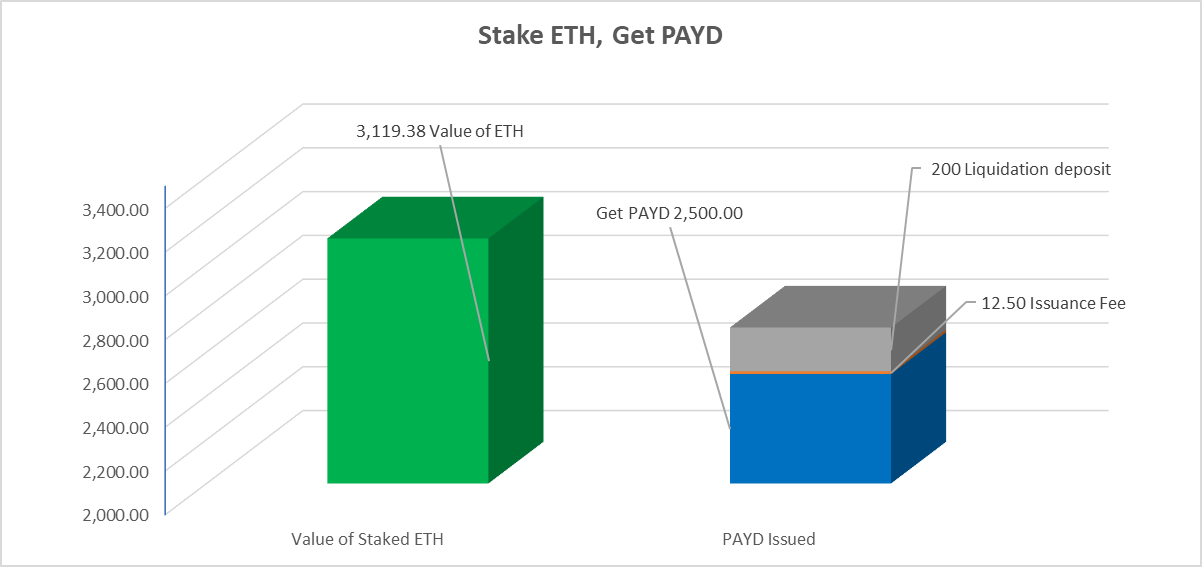Staking & Unstaking ETH
To use the platform, individuals and/or corporations must submit their application and get approved via a KYC (know-your-customer) process. Once details are verified and approved, users connect their Metamask wallet to interact on the platform.
Opening A Cache
In staked.finance, the user opens a cache the first time they stake ETH and issue PAYD. The cache position refers to the ratio of ETH staked and PAYD issued at any given time. Cache position at the current ETH to USD price is also known as the individual reserve ratio.
Individual Reserve Ratio (IRR) = (ETH staked * Current Price) / Total PAYD Issued.
Opening a cache requires a minimum drawdown of 2,500 PAYD, plus a liquidation deposit of 200 PAYD and an issuance fee (from 0.5% - 5.0%) of the drawdown PAYD.
For example, if 2,500 PAYD is drawn from the ETH stake, the total PAYD issued will be 2,712.50 PAYD
- 2,500 PAYD drawdown
- 200 PAYD liquidation deposit (returned when cache is closed)
- 12.5 PAYD issuance fee (0.5% of 2,500 PAYD)
To drawdown 2,500 PAYD, the user must stake ETH that is >= 115% of the total PAYD issued of US$2,712.50.
Risk Of Liquidation
It is important to make sure that you are issuing PAYD at a comfortable risk level to you, so you know the range of ETH price fluctuation will cause your cache to be liquidated.
The user's cache risk is determined by the user's IRR following the risk categories below.
Entry: >= 350% IRR
Stable: >= 200% and <350% IRR
YOLO: >= 115% and <200% IRR
Example
To drawdown 2,500 PAYD - the user must stake at least $3,119.38 worth of ETH (or 1.03979166666667 ETH @ US$3,000 per ETH). This would put the user at the YOLO risk level and will be at risk of being liquidated once price of ETH drops under US$3,000.
This user could reduce their risk by increasing the amount of ETH staked so that their IRR will increase beyond 115%.

How does recovery mode restrict cache opening?
In rare situations where the entire system is undercollateralized (see Recovery Mode), to open a new cache position, this cache will need to have an individual reserve ratio (IRR) >= 155% and increase the system's total reserve ratio (TRR) >= 155%.
If your intended cache position does not fulfill both criteria, you will be restricted from opening a cache until normal operation is resumed.
Managing Your Cache
Users with an active Cache can
- Stake ETH
- Unstake ETH*
- Drawdown PAYD
- Payback PAYD.
*Users can unstake their ETH at any time depending on the available ETH liquidity.
While managing the cache, the IRR must be maintained >= 115%. If the user wishes to unstake all their ETH, they must close cache instead.
Example
User payback 14,000 PAYD and unstakes 5 ETH.
[ Initial Stake Table ]
Step 1:
Repay 14,000 PAYD

Step 2:
Drawdown 5 ETH

During Recovery Mode, you can only take the following actions for cache management:
- Stake ETH
- Payback PAYD
Users are not able to unstake ETH or drawdown PAYD during Recovery Mode.
Closing Your Cache
Users who want to close their cache must payback their total PAYD issued (minus the liquidation deposit). Upon closing their cache, all their staked ETH will be transferred to their wallet. This action may be restricted if there is not enough ETH liquidity.
staked.finance (SF1) is in the midst of a applying for a DPT licence with the Monetary Authority of Singapore. Please note that during this period, our website may change and be refined over time.